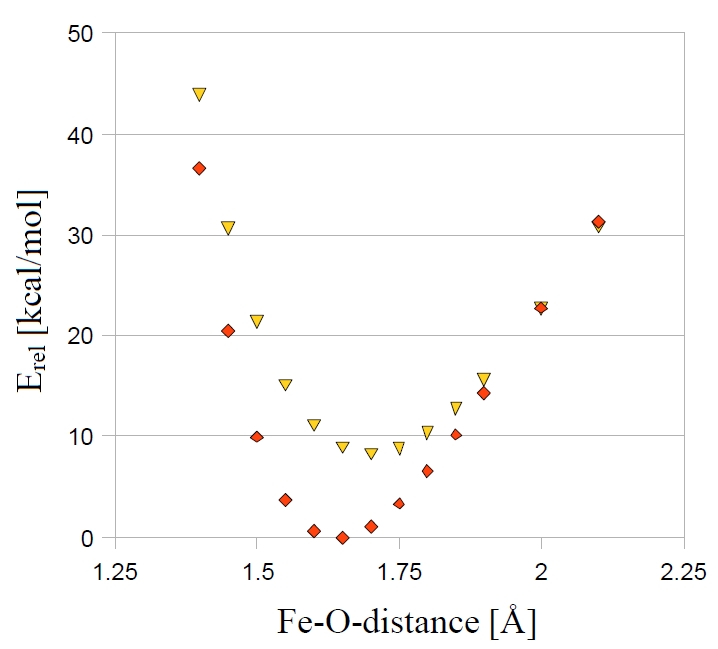4.9. Minimum Energy Crossing Points (MECP)¶
The MECP optimization allows the user to optimize to structures where two different potential energy surfaces (PES1 and PES2) cross each other. In this optimization two conditions apply: the energy \(E_{1}\) of PES1 is minimized while at the same time the energy difference \(\left({ E_{1} -E_{2} } \right)^{2}\) of both surfaces is minimized. For the implementation we follow in principle the suggestions of Harvey et al. in [538].
For the minimization two different gradients are constructed:
The first gradient chosen for the minimization is
where \(x_1\) is the gradient difference vector
which is orthogonal to the crossing hyperline near the MECP.
The gradient
is orthogonal to \(x_1\).
Both gradients are combined to yield the effective surface crossing gradient
The crossing hyperline is defined as the \(3N-7\) dimensional subspace of PES1, which is orthogonal to \(x_1\). In the MECP optimization we want to find the point of lowest energy within this subspace.
Our calculation of normal modes and force constants for movements along the crossing hyperline differ from the one proposed by Harvey et al. A standard frequency analysis cannot be performed, but a similar procedure is applied:
Let us regard the second-order Taylor expansion for the energy of both surfaces near the MECP for a displacement along the crossing hyperline (orthogonal to \(x_1\)):
with:
\(\mathbf{E}_{A}\) |
Energy E\(_{1}\) on PES1 or E\(_{2}\) on PES2 |
\(H_{\mathrm{eff},A}\) |
effective Hessian for PES1 or PES2 |
\(\Delta q\) |
displacement along the crossing hyperline |
Diagonalization of this effective Hessian gives us the normal modes of the crossing hyperline and thus allows us to decide whether the MECP optimization converged to a minimum in the \(3N-7\) dimensional subspace of the crossing hyperline.
The procedure for the calculation of the effective Hessian is now as follows: For each of both surfaces the second derivative matrix is calculated. Then the 6 rotations and translations and additionally the direction of the gradient difference vector \(x_1\) (this ensures that movement orthogonal to the crossing hyperline, for which we do NOT satisfy the conditions of a stationary point, is excluded) are projected out from the Hessian matrix.
As an example we show the MECP optimization of the quartet and sextet state of [FeO]\(^{+}\).
! B3LYP TZVP Opt SurfCrossOpt SlowConv
%mecp
Mult 4
end
* xyz +1 6
Fe 0.000000 0.000000 0.000000
O 0.000000 0.000000 1.670000
*
Tip
You can often use a minimum or TS structure of one of the two spin states as initial guess for your MECP-optimization. If this doesn’t work, you might try a scan to get a better initial guess.
The results of the MECP optimization are given in the following output. The distance where both surfaces cross is at 1.994 Å. In this simple example there is only one degree of freedom and we can also locate the MECP via a parameter scan. The results of the scan are given in Fig. 4.5 for comparison. Here we see that the crossing occurs at a Fe-O-distance of around 2 Å.
For systems with more than two atoms a scan is not sufficient any more and you have to use the MECP optimization.
***********************HURRAY********************
*** THE OPTIMIZATION HAS CONVERGED ***
*************************************************
-------------------------------------------------------------------
Redundant Internal Coordinates
--- Optimized Parameters ---
(Angstroem and degrees)
Definition OldVal dE/dq Step FinalVal
-------------------------------------------------------------------
1. B(O 1,Fe 0) 1.9940 -0.000001 0.0000 1.9940
-------------------------------------------------------------------
*******************************************************
*** FINAL ENERGY EVALUATION AT THE STATIONARY POINT ***
*** (AFTER 8 CYCLES) ***
*******************************************************
------------------------------------- ----------------
Energy difference between both states -0.000000004
------------------------------------- ----------------

Fig. 4.5 Parameter scan for the quartet and sextet state of [FeO]\(^+\) (B3LYP/SV(P)).¶
A more realistic example with more than one degree of freedom is the MECP optimization of a structure along the reaction path of the CH\(_{3}\)O \(\leftrightarrow\) CH\(_{2}\)OH isomerization.
! B3LYP SV SurfCrossOpt SurfCrossNumFreq
%mecp
Mult 1
end
*xyz 1 3
C 0.000000 0.000000 0.000000
H 0.000000 0.000000 1.300000
H 1.026719 0.000000 -0.363000
O -0.879955 0.000000 -1.088889
H -0.119662 -0.866667 0.961546
*
Note
To verify that a stationary point in a MECP optimization is a minimum, you have to use an adapted frequency analysis, called by
SurfCrossNumFreq.
4.9.1. Keywords¶
For MECP optimizations the following options exist:
%mecp
SurfCrossOpt true # switches on the MECP optimization
# alternatively use: ! SurfCrossOpt
SurfCrossNumFreq true # switches on the MECP effective Hessian
# calculation
# alternatively use: ! SurfCrossNumFreq
# separate MO input for the second spin state (PES2)
moinp "Myfile.gbw"# MO input for PES2
# information on the electronic structure of PES 2
Mult 3 # multiplicity of PES2
brokenSym 1,1 # broken symmetry for PES2
# CASSCF options for PES2 (also see the CASSCF chapter)
casscf_nel 6 # number of active space electrons
casscf_norb 6 # number of active orbitals
casscf_mult 1,3 # multiplicities singlet and triplet
casscf_nroots 4,2 # four singlets, two triplets
casscf_bweight 2,1 # singlets and triplets weighted 2:1
casscf_weights[0] = 0.5,0.2,0.2,0.2 # singlet weights
casscf_weights[1] = 0.7,0.3 # triplet weights
end